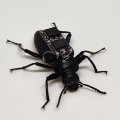The haunting beauty of whales singing in the depths of the oceans is the focus of new research at The University of Queensland.
Dr Michael Noad, from the School of Veterinary Science, is leading a team of researchers focusing on the humpback whale, trying to unravel the mystery of not only what the whales are singing about but why they do it in the first place.
As part of an international project, the Humpback Acoustic Research Collaboration (HARC), the UQ team is focusing on what is the significance and roles of singing and how the whales react to other noises in their environment.
Dr Noad said with a growing controversy about how man-made noises are affecting marine life, it was hoped this research would shed new light on the subject.
“There are many sources of noise in the ocean including increased commercial shipping,” Dr Noad said.
“Most controversy though arises from military sonar and the use of air-guns in oil exploration.
“The problem is there is so much we don’t know about how humpbacks use sound and it is only by knowing this can we predict how man-made sounds may impact upon them.”
Dr Noad, a lecturer in Veterinary Anatomy, said even though whale sound has been studied for many years there was still so much we don’t know.
“Essentially we know a bit about humpback whale behaviour and the structure of song, but we still have little idea about how humpbacks use song to interact with each other and their environment,” he said.
“We know that humpbacks sing tightly structured, long and complex songs but they are only sung by the males and only in the breeding season”
The humpback whale is making a bit of comeback since the dark days of indiscriminate hunting.
Dr Noad said where the population went from 20,000 down to a frightening 100 or 200, recent surveys had seen that number grow back up to around 5000.
HARC is a collaboration involving the Australian Defence Science and Technology Organisation (DSTO), Scripps Institution of Oceanography (SIO), Woods Hole Oceanographic Institution (WHOI) and UQ as well as researchers from the University of Sydney and the University of Newcastle.
The project is funded primarily by the U.S. Office of Naval Research, with additional funding from DSTO and has grown out of previous work conducted in Australia as well as an increasing interest and concern regarding the effects of underwater noise on marine mammals.
DSTO and SIO are providing equipment and expertise, particularly in the areas of underwater acoustic measurement and sound playback, while UQ is organising the fieldwork and conducting visual and acoustic tracking of whales as well as the collection of behavioural, photographic and genetic data from a boat.
Using the field site of Peregian Beach on Queensland’s Sunshine Coast, there are visual surveys from the shore, an array of hydrophone anchored off shore as well as tracking from a boat to monitor how the whales interact at close range. This boat work is being lead by Joshua Smith, a PhD student from the School of Life Sciences.
The study site lies on the migratory path of the east Australian population of humpback whales, one of the best-studied populations of baleen whales in the world.
Every year on the Australia east coast, humpback whales migrate north to the warmer waters of the breeding grounds inside the Great Barrier Reef from May to August and then return southwards to the feeding grounds during August to November.
Dr Noad said another section of the project being conducted by WHOI was using suction cup tags on the whales to measure what they hear.
“The suction tags have a hydrophone which acts like another ear stuck on the side of the whales allowing us to hear what they hear as well as sensing their movements and what depth they go to.
“The beauty of the suction caps is they fall off after a couple of hours and we can retrieve them.
“Finding out what they are hearing and how they are reacting to it is invaluable and tells us a lot of what they do.”
Another part of the project, run by Scripps, is measuring ambient noise in the ocean, particularly surf noise as it is believed the whales may use sound to help them navigate during migration.
He said the final field experiment later this year will also include playback experiments on the whales for the first time during this project.
“Although we can learn a great deal about many aspects of humpbacks’ use and perception of sound through passive observation, the extra experimental control made possible by playback will allow us to explore some aspects of song function and the perception of other sounds in ways that are not possible otherwise,” he said.
He said even though the analysis was in it’s early days, they had already been a able to disprove one theory that the singing was used by males to make sure other males didn’t come into their space.
“Males aren’t using song to drive other males away, rather we suspect it is more a case of attracting females,” he said.
Media: For more information contact Dr Michael Noad (telephone 07 3365 2088) or Andrew Dunne at UQ Communications (telephone 07 3365 2802).
.jpg)

